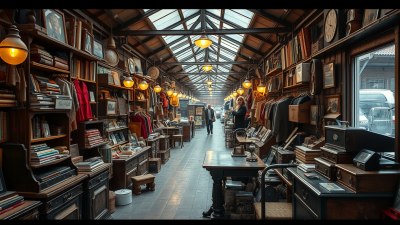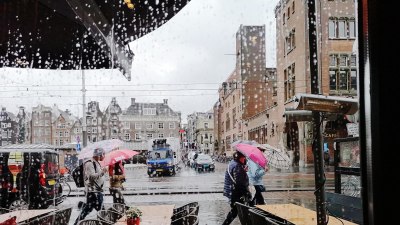The Market Sells Only Forgotten Things
Explore the allure of forgotten treasures in a market that highlights nostalgia and memory.

Image created with Flux Schnell
The Market Sells Only Forgotten Things is more than just a whimsical phrase; it represents an intriguing concept in our modern world where memories often fade into obscurity. As society races forward with the latest technology and trends, elements of the past become elusive. This market stands as a testament to the nostalgia of yesteryears, where items with significant histories find new homes and stories are rekindled.
Each stall in this unique market is filled with remnants of bygone days, from vintage clothes and antique furniture to classic records and long-forgotten books. The ambiance evokes a sense of stepping back in time, creating an atmosphere where visitors can reminisce about moments that once defined their lives.
The Charm of Vintage Goods
In today’s fast-paced culture, there’s a growing appreciation for things that carry a past. Vintage goods embody stories and connections to eras long gone. Items such as typewriters, rotary phones, and vinyl records transport us to a time when life was simpler yet filled with profound experiences. Each piece, whether it’s an intricately designed piece of jewelry or a weathered book, holds the essence of those who owned them before.
People are increasingly drawn to vintage shopping not just for the unique finds, but for the sustainable aspect as well. By choosing to purchase second-hand items, consumers are making environmentally conscious decisions that help reduce waste. This emphasizes the importance of valuing the past while also protecting the future.
Nostalgia as a Marketing Tool
Businesses have tapped into the power of nostalgia as a marketing strategy. Brands are recognizing that consumers often create emotional connections with products that remind them of their childhood or significant life moments. The market's offerings are not just objects, but catalysts for memories that enhance consumer experience and drive sales.
Incorporating vintage aesthetics in advertising or product design has proven effective. The retro visuals and familiar references evoke a sense of familiarity and comfort, encouraging shoppers to reconnect with their past. This nostalgia-driven approach continues to be valid across various industries, from fashion lines inspired by 90s styles to home decor that reflects the charm of previous decades.
Collecting as a Passion
For many, the act of collecting forgotten items evolves into a lifelong passion. Collectors devote time and resources into acquiring pieces that resonate with them personally or hold historical significance. Each collection tells a story—some are focused on specific themes, while others simply reflect the collector's diverse interests.
Join local collecting clubs or participating in online forums is a common way for enthusiasts to share their passion, exchange tips, and even trade items. The thrill of hunting for rare finds becomes a shared experience. Whether it be rare comic books, antique furniture, or vintage clothing, the hunt creates connections between collectors that often transcend mere materialism.
The Role of Storytellers
Every item in the market has a story to tell, and this is where storytellers come into play. Vendors or curators often serve as bridges between the past and present. They delve into the history of the items, sharing anecdotes and information about their previous owners or the time period they represent. This storytelling elevates the shopping experience, allowing buyers to feel more connected to their purchases.
Storytelling allows vendors to create a narrative that enhances the overall ambiance of the market. It encourages emotional connections, ultimately enhancing perceived value. For example, a piece of furniture may become a cherished family heirloom when coupled with a tale about its origin, such as being passed down through generations.
Meet the Unseen Artists
In a market filled with forgotten items, there exists a unique group of artisans and craftspeople who specialize in repurposing and upcycling. These creators transform old and neglected goods into modern masterpieces, breathing new life into forgotten things. From handcrafted jewelry made from antique silverware to furniture restored with contemporary flair, these artists merge the charm of history with the aesthetics of today's designs.
Shoppers are increasingly drawn to these one-of-a-kind finds, valuing the craftsmanship and creativity involved in the transformation process. Supporting local artisans encourages sustainability while simultaneously allowing the consumer to own something unique—something that reflects both the past and present.
The Market Experience
Visiting a market that sells forgotten things can be a delightful journey. It offers an escape from the mundane shopping experience. Engaging with stall owners, exploring the aisles, and unearthing hidden gems is a treasure hunt in a sea of nostalgia. The smells, sounds, and sights conjure memories that may not have been recalled in years, creating an emotional tapestry of shared history.
Interactive experiences, such as workshops or curated exhibitions, further enrich the market atmosphere. Whether participants are learning how to restore a piece of furniture, creating art from upcycled materials, or discovering the art of storytelling behind vintage finds, these experiences deepen connections with the past.
A Place for Reflection
Amid the hustle and bustle of contemporary life, the Market for Forgotten Things serves as a refuge for reflection. It reminds us of the importance of memory in shaping who we are. Consumers often seek out items that remind them of family members, childhood experiences, or pivotal moments—creating a powerful emotional resonance.
In a society heavily influenced by digital technology, there’s an inherent comfort in tangible items that ground us. A simple photograph, a cherished toy, or a piece of clothing from a loved one can transport us back to foundational moments of our lives. The act of remembering becomes a form of nostalgia that binds us as humans.
Embracing Memory in Marketing
Businesses are becoming increasingly savvy about incorporating memorability into their marketing strategies. Creating campaigns that evoke nostalgia can lead to higher engagement levels and deeper emotional connections. Brands utilize historical references, iconic imagery, and familiar sounds to create ads that resonate with audiences on a personal level.
For example, a contemporary clothing brand might choose to launch a collection inspired by trends from the 80s or 90s, well-known decades that evoke fond memories for many consumers. By tapping into that nostalgia, the brand strengthens its appeal, ultimately driving sales.
A Reflection on Forgotten Things
The Market Selling Only Forgotten Things is an enchanting realm where the past meets the present. It encourages visitors to explore the concept of memory and connection while celebrating the artistry and stories that permeate every item. In recognizing the beauty in forgotten things, we also embrace the fleeting nature of time, cherishing the moments and memories that shape our journey.
In a fast-moving world, there's something profoundly comforting about returning to our roots—to the things that remind us of who we are and where we come from. This market stands as a beacon of the importance of our past, allowing the forgotten to flourish within the embrace of memory.











